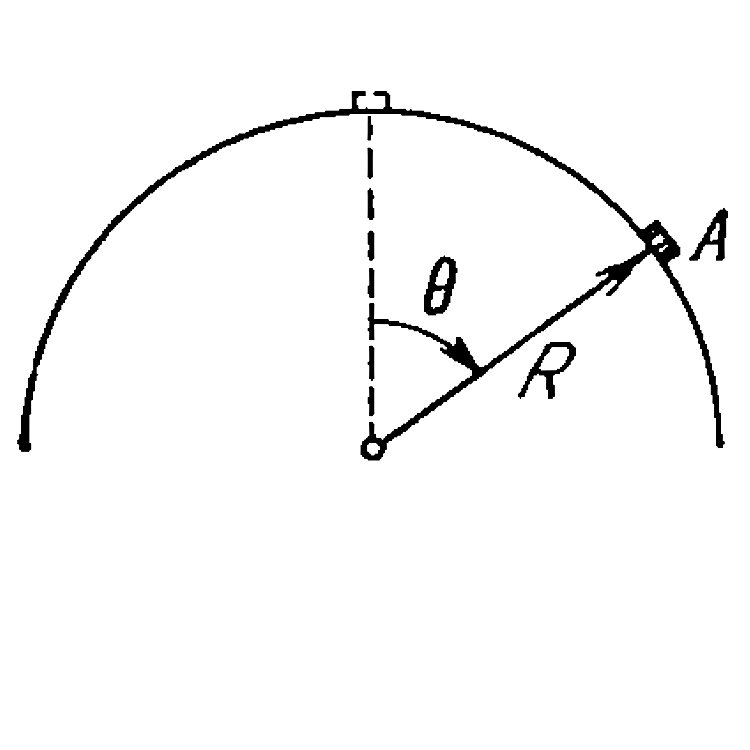A small body A starts sliding off the top of a smooth sphere of radius R. Find the angle θ Fig. 1.25 corresponding to the point at which the body breaks off the sphere as well as the break-off velocity of the body.
Let us depict the force acting on the body A Which are the force of gravity m vector g and the
Related Solutions
A small body A starts sliding off the top of a smooth sphere of radius R. Find the angle (figure) corresponding to the point at which the body breaks off the sphere, as well as the break-off velocity of the body.

View SolutionA small body is placed on the top of a smooth sphere of radius R. Then the sphere is imparted a constant acceleration in the horizontal direction and the body begins sliding down. Find:
(a) the velocity of the body relative to the sphere at the moment of break-off,
(b) the angle between the vertical and the radius vector drawn from the centre of the sphere to the break-off point, calculate for .
View SolutionA particle of mass starts to slide down from the top of the fixed smooth sphere. What is the tangential acceleration when it break off the sphere ?
View SolutionA particle of mass m starts to slide down from the top of the fixed smooth sphere. What is the tangential acceleration when it break off the sphere ?
View SolutionA particle of mass m begins to slide down on a fixed smooth sphere from the top, when it breaks off the sphere, the tangential accleration will be
View SolutionA particle of mass m being to slide down a fixed smooth sphere from the top as shown. If its acceleration when it breaks off the sphere is 2a. The value of a is :

View SolutionA uniform ball of radius r rolls without slipping down from the top of a sphere of radius R Find the angular velocity of the ball at the moment it breaks off the sphere. The initial velocity of the ball is negligible.
View SolutionA uniform ball of radius r rolls without slipping down from the top of a sphere of radius R Find the angular velocity of the ball at the moment it breaks off the sphere. The initial velocity of the ball is negligible.
View SolutionA uniform ball of radius rolls without slipping down from the top of a sphere of radius Find the angular velocity of the ball at the moment it breaks off the sphere. The initial velocity of the ball is negligible.
View SolutionA point mass m starts to slide from rest from the top of a smooth solid sphere of radius r. Calculate the angle at which the mass flies off the sphere. If there is friction between the mass and sphere, does the mass fly off at a greater or lesser angle ?
View SolutionA small body of mass m=0.30kg starts sliding down from the top of a smooth sphere of radius R=1.00m . The sphere rotates with a constant angular velocity omega=6.0rad//s about a vertical axis passing through its centre. Find the centrifugal force of inertia and the Coriolis force at the moment when the body breaks off the surface of the sphere in the reference frame fixed to the sphere.
View SolutionA body starts falling from the top of a smooth sphere of radius r. What angle does the body subtend at the centre of the sphere when it just loses contact with the sphere and what will be its velocity then ?
View SolutionA small body is placed on the top of smooth sphere of radius R. The sphere is imparted a constant acceleration = ng in the horizontal direction. The body begins sliding down. Find the velocity of body relative to the sphere at the moment it just leaves the surface of sphere:
View SolutionA small body is placed at the top of a smooth sphere of radius r. what should be the horizontal velocity given to the body so that it loses contact with the sphere when its height from the centre of the sphere is (4r)/(5) ?
View SolutionA small body A starts sliding from the height h down an inclined groove passing into a half-circle of radius (figure).

Assuming the friction to be negligible, find the velocity of the body at the highest point of its trajectory (after breaking off the groove).
View SolutionA small body A starts sliding from the height h down an inclined groove passing into a half-circle of radius h//2 (figure). Assuming the friction to be negligible, find the velocity of the body at the highest point of its trajectory (after breaking off the groove).
View SolutionA small object of mass m = 0.3 kg starts sliding down from the top of a smooth sphere of radius R = Im. The sphere rotates with a constant angular velocity w = 6.0 rad.s- about the vertical axis passing through the centre. The centripetal force which tries to keep the body in contact at the point breaking off the surface of the sphere
View SolutionA small mass m starts from rest and slides down the surface of a frictionless solid sphere of radius R. Calculate the angle at which the mass flies off the sphere. If there is friction between the mass and the sphere, does the mass of fly off at a greater or lesser angle than the previous one ?
View SolutionAt the moment t=0 the force F=at is applied to a small body of mass m resting on a smooth horizontal plane (a is constant). The permanent direction of this force forms an angle alpha with the horizontal (figure). Find: (a) the velocity of the body at the moment of its breaking off the plane, (b) the distance traversed by the body up to this moment.
View SolutionAt t=0, a force F = kt is applied on a block of mass m making an angle with the horizontal . Suppose surfaces to be smooth. Find the velocity of the body at the time of breaking off the plane.

View Solution